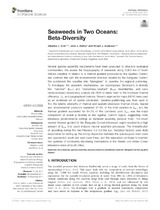| dc.contributor.author | Smit, Albertus J. | |
| dc.contributor.author | Bolton, John J. | |
| dc.contributor.author | Anderson, Robert J. | |
| dc.date.accessioned | 2018-01-03T13:24:14Z | |
| dc.date.available | 2018-01-03T13:24:14Z | |
| dc.date.issued | 2017 | |
| dc.identifier.citation | Smit, A.J. et al. (2017). Seaweeds in two oceans: beta-diversity. Frontiers in Marine Science, 4: 404 | en_US |
| dc.identifier.issn | 2296-7745 | |
| dc.identifier.uri | http://dx.doi.org/10.3389/fmars.2017.00404 | |
| dc.identifier.uri | http://hdl.handle.net/10566/3345 | |
| dc.description.abstract | Several species assembly mechanisms have been proposed to structure ecological
communities. We assess the biogeography of seaweeds along 2,900 km of South
Africa’s coastline in relation to a thermal gradient produced by the Agulhas Current,
and contrast this with the environmental structure created by the Benguela Current.
We subdivided the coastline into “bioregions” to examine the regional patterning.
To investigate the assembly mechanisms, we decomposed Sørensen’s b-diversity
into “turnover” (bsim) and “nestedness-resultant” (bsne) dissimilarities, and used
distance-based redundancy analysis (db-RDA) to relate them to the Euclidean thermal
difference, dE, and geographical distance. Moran’s eigenvector maps (MEM) were used
as an additional set of spatial constraints. Variation partitioning was then used to
find the relative strengths of thermal and spatially-structured thermal drivers. Spatial
and environmental predictors explained 97.9% of the total variation in bsim and the
thermal gradient accounted for 84.2% of this combined pool. bsim was the major
component of overall b-diversity in the Agulhas Current region, suggesting niche
influences (environmental sorting) as dominant assembly process there. The much
weaker thermal gradient in the Benguela Current-influenced region resulted in a high
amount of bsne that could indicate neutral assembly processes. The intensification
of upwelling during the mid-Pliocene 4.6–3.2 Ma (i.e., historical factors) were likely
responsible for setting up the strong disjunction between the species-poor west coast
and species-rich south and east coast floras, and this separation continues to maintain
two systems of community structuring mechanisms in the Atlantic and Indian Ocean
influenced sides of South Africa. | en_US |
| dc.language.iso | en | en_US |
| dc.publisher | Frontiers Media | en_US |
| dc.rights | Copyright © 2017 Smit, Bolton and Anderson. This is an open-access article
distributed under the terms of the Creative Commons Attribution License (CC BY).
The use, distribution or reproduction in other forums is permitted, provided the
original author(s) or licensor are credited and that the original publication in this
journal is cited, in accordance with accepted academic practice. No use, distribution
or reproduction is permitted which does not comply with these terms. | |
| dc.subject | Beta-diversity | en_US |
| dc.subject | Species assembly | en_US |
| dc.subject | Seaweed | en_US |
| dc.subject | Turnover | en_US |
| dc.subject | Nestedness-resultant | en_US |
| dc.subject | Benguela Current | en_US |
| dc.subject | Agulhas Current | en_US |
| dc.title | Seaweeds in two oceans: beta-diversity | en_US |
| dc.type | Article | en_US |
| dc.privacy.showsubmitter | FALSE | |
| dc.status.ispeerreviewed | TRUE | |

